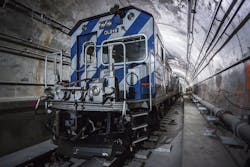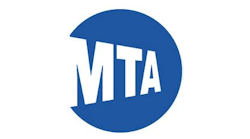New York Metropolitan Transportation Authority’s (MTA) Second Avenue Subway is a 4.45 billion dollar project that has been in the making for the past 87 years. The subway line runs from 125th Street to the Financial District in Manhattan.
Michael Horodniceanu, president of MTA Capital Construction said, “It goes all the way back to 1929 and had a lot of starts and stops on the way. In the '70s they actually decided to build it, they put out a call for contracts.”
One of the contracts was canceled quickly and soon Horodniceanu said MTA was left with two tunnels and construction and planning stopped until the late nineties — when the project was reignited. “It started with a Major Investment Study (MIS) and Draft Environmental Impact Statement (DEIS); we then received the funding” Horodniceanu said. Currently underway, the project is slated to be completed by December 2016.
“I came to MTA and the project at the end of July 2008. My first job was to look at the budgets and the schedule and determine their viability. I completed and established that by December of 2008. It was voted and approved by the board in June of 2009 and we have stayed on course since that time,” explained Horodniceanu. The real construction started in 2008 and we put a shovel into the ground.”
The Second Avenue Subway project is 95 percent complete, the last 5 percent, Horodniceanu said, is still a challenge. The line needs to be tested and every aspect must be tested to ensure that the procedures are up to MTA’s standards.
“We have to abide by whatever new requirements; fire protection is an example, so we have brand new fans that are housed at the end of each station. If you looked at it you would think that they are rockets ready to go to the moon. We test them for endurance and we test them for continued hours. We’re doing things now where we’re looking at much larger systems than we ever did.”
Updating an Older System
As the first subway systems in the city of New York are 100 years old, they were built in a highly different fashion than what MTA did with the Second Avenue Subway. The older subways were built primarily by doing cut-and-cover.
"The connection and rail alignment was an important and fundamental baseline criterion to meet between the existing stations at 63rd Street and a finished box left for the future at the 96th Street Station. In between, the station adjustments in the vertical alignment were adjusted to address geological (rock datum) factors in concert with construction methodologies," said Liam Dalton, P.E., project manager for Aecom. "To mitigate a large scale cut and cover approach, a tunnel boring machine was used to bore the tunnels in the Manhattan rock and mine the stations in accordance to the Environmental Impact Statement (EIS) station locations. The rail alignment also included studies coming out of the EIS for station entrance locations, which led to early design decisions of in-building entrances and entrances located on sidewalks."
“They are not too deep, they maybe go down about 30 to 35 feet and then if you come to our stations you’re going to be welcomed by a forest of columns, in the center line as well as along the platforms,” explained Horodniceanu. “The new construction that we’ve put it place is actually much deeper. The new stations on 2nd Avenue are all around 100 feet below ground, with the exception of 96th Street, that needs to connect with a cut-and-cover tunnel that was built in the '70s.”
"The existing NYCT transit system was designed on 5-foot centers utilizing a simple post/column and beam approach. It was an efficient, engineered structural approach to the early subway construction. The approach to Second Avenue Subway studied and implemented a fresh view with an eye towards a new underground station design," said Dalton.
The new design will have larger designed platforms that Horodniceanu described as "soaring and inviting" rather than the more claustrophobic feel of the existing system.
“We have used the national fire protection new standards, the P1-30, and we are now making them how we were meant to make stations, very different compared to the existing system which I sometimes refer to as the 'Marilyn Monroe ventilation system,'” said Horodniceanu. “That is part of the past; we don’t do that anymore; we have a much more robust way of dealing with smoke.”
"Ancillary buildings are new programmatic functions housing the emergency ventilation fans for smoke extraction of stations or from tunnels in addition to tunnel ventilation shafts,"explained Dalton. "New to the system are north and south ventilation fan plants located at each of the new Second Avenue Subway stations. The ancillary buildings are the 'lungs' to the new underground stations."
Utilizing New Technology
"In terms of systems interfaces, there are existing systems in the current transit system which required connectivity to new construction. With that are the challenges of the age of the system and how to incorporate into new platforms, such as with fire alarm systems and public address," said Dalton. "Other systems in operating a running railroad come from NYCT such as signaling and communications, which are more standardized from the railroad."
All of the cut-and-cover was done as Horodniceanu describes, "semi-manually," with people utilizing a tunnel boring machine. The Manhattan schist is hard rock, but when using the boring machine there were areas that if a tunnel was to be put in, the ground needed to be frozen.
“Technology has improved and we were able to freeze the ground over a period of about 5 months and it was a couple of blocks long; we would come back in after that and tunnel through it. So again, that’s technology at work.”
When using the boring machine there was one point where when excavating a slurry wall, a steel panel was stuck — and they were unable to cut it away.
“We did something that I don’t believe was ever done. We have in affect secured the services of a diver and the diver went into the slurry, totally blind, went all the way to the bottom, used an underwater blow torch, cut away the piece that was stuck and that enabled us to lift up the piece of steel in order to continue our work. So this is something quite frankly, I don’t know if it was done, if we did not have the ability to have the diver to go down there, we probably would not have been able to do that — so imagine us going 120 feet down a diver going into a totally dark environment and having to cut steel while not being able to see anything — that’s something that we probably couldn’t have done 50 years ago.”
When talking subway construction, excavating the tunnels and installing tracks is typically the first thing to come to mind — but what about concrete?
“We are placing a lot of concrete 100-feet down from the street. As you know, trucks don’t get down 100 feet and the concrete comes from the surface. Manhattan is a very busy city in terms of traffic, so it takes you a long time to go one block. Well the concrete normally requires that you place it within one and a half hours from when you leave the plant. The problem is the plant is not next to our site.”
Faced with that challenge, Horodniceanu said they once again had to use technology to get creative.
“We needed to put an additive to delay the chemical reaction that will harden the cement with the aggregate in the concrete,” said Horodniceanu. “Then we brought the truck to the site, which took time, and because of the demand of the job, you need to have tracks lined up one after another to pump the concrete. So you put an additive to extend the time, but when you pour it you need to put an accelerator to pour it to reverse the reaction.”
Flowing With the City
"One of the biggest accomplishments thus far with the Second Avenue Subway has been maintaining the project schedule and budget on a program of this size, with construction of three new stations and reconstruction of one existing station taking place in a 24-hour environment with the disruption to the community overall being minimized," said Dalton. "The Aecom/Arup team role on the project has been to streamline the construction process, serve as a link between the design and construction, and work with the contractors — which includes coordination with 10 separate general contractors."
A well-known aspect of construction is residents don’t enjoy having it outside their homes or work places. Horodniceanu said that along Second Avenue there are 100,000 residents per square mile. With the work that needed to be done there was a great deal of blasting, vibrations and smoke as a byproduct of the construction.
“That means that we have continuously been building in front of people’s living rooms, which does not buy us many friends. Construction is not immaculate and we had to do lots of things in order for us to control construction's impact on the population,” Horodniceanu said. “We had to put in mud houses, because we had a lot of blasting and taking out the Manhattan shift, we had to put it in trucks and haul it away and we had to blast underground to actually create the caverns.”
At every station Horodniceanu said that they built mud houses. The structures were about 200 feet long and 45 feet high and 20 some feet wide. "These are the areas where when we would blast all the residual air and dust would actually vent through this facility so that we were in affect able to separate the site below from the site above. In many instances you generate lots of dust so we brought in mining technology to scrub the air from below, so in a strange way we created a better environment below by scrubbing the air we’re cleaning the area above."
“We have developed a model that has not been utilized in the past and the sense that this project was very different. I decided that in order to get the credibility and the trust of the residents I needed to put my face on the project. What I mean by that is, I needed them to trust me in what I do and I needed them to hear that the buck stopped with me," Horodniceanu said. "The most important ingredient here was to tell the truth, tell it the way it is, do the talk and walk the walk. People can only be fooled once, so we did a very comprehensive outreach where we created a community information center in the middle of the project. We are having somewhere in the vicinity of almost 20,000 people visiting.”
Horodniceanu also spent time going to schools to educate children on what was going on in the area. He also personally conducted tours on Saturdays, taking residents on an underground walk of the construction. “It’s much tougher above ground when you are the recipient of dust and noise to understand what is happening below ground. Once we were able to take people underground it was something that worked well.”
Dalton said that Aecom is currently providing support to make the subway a seamless opening. "We are facilitating construction phase support services to the construction manager and contractors across the four station contracts. We are supporting testing and commissioning and have expert technical staff on the owners management team; support necessary change to the program with scope development, engineering, estimate and change documentation; keep up with routine engineering reviews and RFI responses; and facilitate program risk management."
When the Second Avenue Subway does open, Horodniceanu said that they expect about 200,000 thousand riders for day one.






